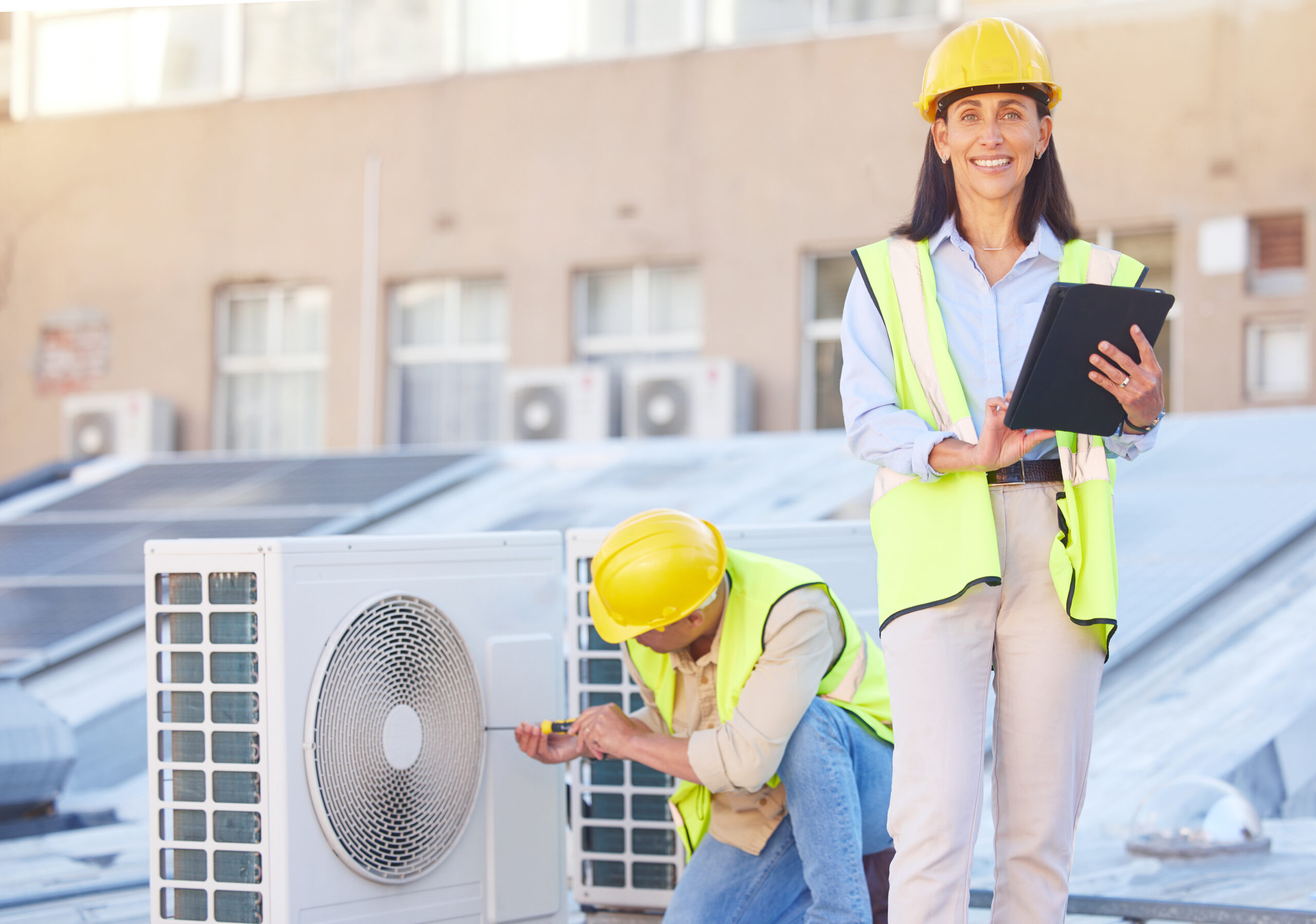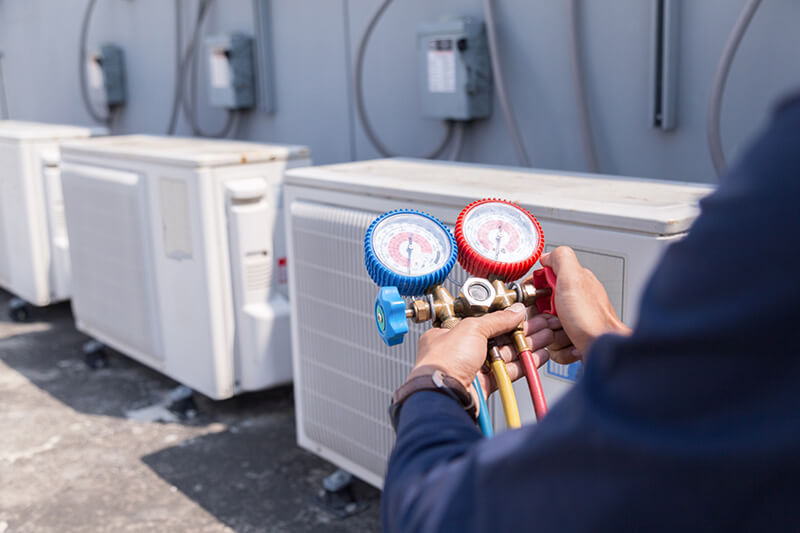Avoid Costly Repairs with Scheduled heat pump service
Avoid Costly Repairs with Scheduled heat pump service
Blog Article
Exactly How a Warm Pump and Heating System Interact to Maximize Your Home's Home heating Performance
Understanding how a heatpump and heating system interact is necessary for homeowners looking for effective heating services. Each system has its strengths, offering a balanced approach to home convenience. The warmth pump masters moderate temperatures, while the heating system provides quick heat during extreme cold. This harmony not only lowers energy expenses yet likewise enhances the life-span of both home appliances. What variables affect this partnership, and how can home owners maximize their benefits?
Understanding Warm Pumps: Exactly How They Function
Many people might be strange with their inner functions, warm pumps play a necessary duty in modern-day home heating systems. These tools run by moving warm from one area to one more, utilizing the concepts of thermodynamics. In cooler months, a heatpump removes warm from the outside air, ground, or water, and transfers it indoors to heat the home. Alternatively, throughout warmer months, it can turn around the procedure, acting as an air conditioning unit by getting rid of heat from inside to the outside.Heat pumps contain an evaporator, condenser, compressor, and development valve. The refrigerant within the system absorbs warm as it evaporates at reduced temperature levels and stress. The compressor then boosts the stress and temperature level of the refrigerant, enabling it to launch warmth as it condenses. This efficient process can significantly reduce energy consumption compared to typical heating approaches, making heat pumps a lasting choice for climate control in homes.
The Function of Heating Systems in Home Heating
Furnaces play an essential function in home heating by supplying a reliable source of warmth throughout the chillier months. They operate by creating warm through burning or electrical resistance, dispersing it throughout the home by means of air ducts or radiant systems. The efficiency of a furnace is frequently determined by its Annual Gas Use Effectiveness (AFUE) score, which suggests how successfully the system transforms fuel right into heat.Furnaces can use numerous power resources, consisting of gas, electricity, oil, or gas, enabling homeowners to choose one of the most appropriate option for their requirements. Unlike heatpump, which might have a hard time in severe cool, heaters keep consistent efficiency, making sure that interior temperatures continue to be comfortable no matter exterior conditions. In addition, modern heaters often come equipped with sophisticated technology, such as smart thermostats and variable-speed blowers, enhancing their performance and responsiveness. This adaptability makes furnaces a vital element in all-encompassing home heating techniques.

Advantages of Using Both Systems With Each Other
Integrating the staminas of both furnaces and heatpump can lead to a much more reliable and efficient home heating remedy. Making use of both systems enables house owners to make the most of the heatpump's power efficiency during milder temperature levels while depending on the heater for even more extreme cold conditions. This dual technique can greatly reduce energy costs, as heatpump eat less electricity than typical home heating approaches when temperature levels are moderate.Additionally, using both systems with each other can enhance comfort levels in the home. Heatpump can give consistent, also heating, while heaters can swiftly raise ambient temperature levels when needed. The assimilation of both systems can prolong the lifespan of devices by lowering wear and tear on each system, as they share the workload. Inevitably, home owners can enjoy a balanced, cost-effective heating solution that changes flawlessly to differing weather conditions, making certain a warm and inviting home throughout the winter months.
Just How Warmth Pumps and Furnaces Enhance Each Various Other
When property owners integrate warmth pumps and heaters, they create a corresponding home heating system that optimizes effectiveness and comfort. Heatpump operate by moving warmth from the outdoors air or ground, making them very effective in modest environments. They stand out during milder temperature levels, giving affordable home heating. Conversely, furnaces generate heat with combustion or electric resistance, providing solid, immediate warmth throughout severe cold conditions.The combination of these two systems allows for dynamic changes based on temperature fluctuations. Throughout warmer months or milder wintertime days, the heat pump can take the lead, saving energy and minimizing prices. As temperatures decline, the furnace can seamlessly involve, guaranteeing consistent heat throughout the home. This synergy not just enhances energy use but likewise boosts the lifespan of both systems, as each system runs within its optimal efficiency range. Together, they develop a well balanced environment that adjusts to differing climate needs.
Maximizing Performance: Tips for Homeowners
Property owners can boost their home heating performance with numerous useful strategies. Developing a normal upkeep timetable, incorporating clever thermostat innovation, and executing efficient insulation and sealing services are key actions. These steps not only improve convenience but additionally minimize energy costs.
Regular Maintenance Set Up
To assure optimal heating efficiency, establishing a normal upkeep routine is essential for any type of home. Property owners ought to prioritize regular assessments of both heat pumps and heating systems to determine peak performance. This includes transforming air filters each to 3 months, as clogged up filters can considerably decrease efficiency. In addition, organizing specialist maintenance at least once a year allows service technicians to recognize and resolve possible issues prior to they escalate. House owners must additionally clean the heatpump's outdoor unit to stop particles accumulation that can impede airflow. By adhering to a regular maintenance routine, property owners not just enhance their heater' effectiveness but likewise expand their life-span, bring about better comfort and decreased power expenses throughout the chillier months.
Smart Thermostat Assimilation
Integrating a clever thermostat into a home furnace can considerably enhance power efficiency, particularly as it allows for accurate control over temperature setups. These gadgets can find out the homeowner's schedule and preferences, instantly changing the temperature article source to optimize convenience while reducing power usage. They official site can decrease home heating throughout times when the home is empty, decreasing unnecessary intake. Numerous smart thermostats additionally give real-time power use information, enabling home owners to make educated choices regarding their home heating behaviors. In addition, remote gain access to using mobile phone apps enables users to readjust setups from anywhere, making sure the home is warm upon return. Generally, wise thermostat assimilation not just enhances comfort yet substantially adds to energy savings and efficiency.
Insulation and Securing Solutions
Smart thermostats play an important duty in power efficiency, but their efficiency can be greatly enhanced by appropriate insulation and sealing options. Home owners ought to focus on protecting floorings, attics, and walls to minimize warmth loss. High-quality insulation products, such as spray foam or fiberglass, can greatly enhance thermal resistance. In addition, sealing voids around doors, home windows, and air ducts avoids cool air infiltration and heat retreat. Weatherstripping and caulking are reliable techniques for resolving these leaks - ductless mini splits. Routine examinations for air leaks, together with the use of blower door tests, can help determine issue areas. By investing in insulation and sealing, home owners can maximize the performance of their heating unit, eventually leading to minimized power consumption and reduced energy costs
Typical Misconceptions About Warm Pumps and Furnaces
What mistaken beliefs surround warm pumps and heating systems? Several Visit Website people incorrectly think that warm pumps are ineffective in chillier environments. Actually, modern-day warmth pumps are designed to run successfully even in low temperatures, offering trustworthy home heating throughout winter season. An additional usual myth is that heaters are constantly extra efficient than warm pumps. Nevertheless, this depends upon the details energy resources and effectiveness ratings of the devices in inquiry. Some may likewise believe that using both systems simultaneously is unneeded, however in reality, this combination can maximize home heating efficiency, specifically during extreme weather problems. In addition, people commonly think that heatpump require constant maintenance, when in truth, they have similar maintenance needs to traditional heating unit. By debunking these myths, house owners can make more informed choices regarding their home heating alternatives, ultimately leading to improved convenience and power efficiency in their homes.
Upkeep Factors To Consider for Combined Solutions

Often Asked Inquiries
Can Warm Pumps Job Efficiently in Extremely Cold Climates?
Heatpump can have a hard time in extremely cold environments because of reduced performance and warmth removal limitations. Advancements in innovation have led to versions developed for far better performance in such problems, boosting their feasibility in harsh settings.
For How Long Do Warm Pumps and Furnaces Usually Last?
Warmth pumps typically last 15 to twenty years, while heaters have a life-span of 15 to 30 years. Routine upkeep can expand their long life, guaranteeing reliable procedure and reducing the demand for early substitutes.

What Is the Typical Expense of Setting Up Both Solutions?
The average cost of mounting both a heat pump and a heater normally varies between $5,000 to $10,000 - ductless mini splits. Factors influencing this cost consist of system size, installation intricacy, and local labor rates
Are There Tax Motivations for Utilizing Energy-Efficient Heating Solutions?
Lots of home owners make inquiries about tax obligation incentives for energy-efficient heating systems. Numerous government and state programs frequently supply credits or refunds, urging the fostering of lasting technologies to minimize energy consumption and promote ecological obligation.
Just how Do I Select the Right Size Warm Pump and Heater?
Selecting the right size warmth pump and furnace involves determining the home's square footage, thinking about insulation high quality, and examining neighborhood climate. Consulting a specialist can ensure excellent system efficiency and energy efficiency based upon specific demands. heat pump service. Comprehending how a warmth pump and heating system work together is important for homeowners seeking efficient home heating remedies. In chillier months, a warmth pump removes warmth from the outside air, ground, or water, and transfers it indoors to heat the living space. When homeowners integrate warm pumps and heating systems, they create a corresponding heating system that takes full advantage of efficiency and convenience. Warm pumps operate by moving warmth from the outside air or ground, making them highly effective in modest climates. Warm pumps can struggle in very chilly climates due to minimized performance and warmth extraction restrictions
Report this page